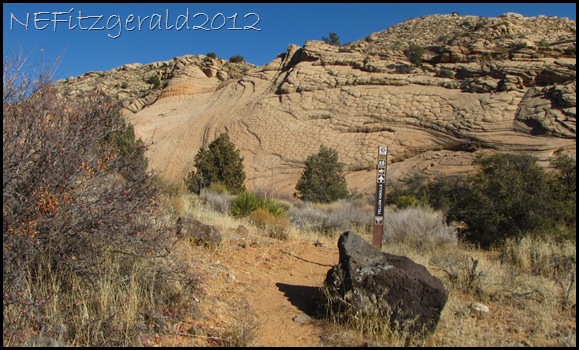It can’t be helped. During the winter I find myself drawn to all sorts of hidden corners of the Red Cliffs Desert Reserve. If you have ever been to southern Utah you will understand why.
 |
| Yellow Knolls In the Red Cliffs Desert Reserve |
You can swing a cat from atop the cliffs of nearby Zion National Park and it will most likely land somewhere in the Desert Reserve. That relatively short distance translates into the same rock formations outcropping in both Zion and the Desert Reserve. I’m talking here about the Navajo Sandstone.
Even if you don’t know its name or what it actually represents, you probably recognize the Navajo Sandstone when you see it. Its massive sheer walls are distinctive and in Zion Canyon tower several thousand feet above the canyon floor.
 |
| Hanging valley in cliffs of Navajo Sandstone, Zion National Park |
Hanging valleys, blind arches, desert varnish, cross–bedding, horizontal and vertical fractures and grooves, and fresh–water seeps all characterize the fossilized sand dune desert that is the soul of the Navajo Sandstone in Zion. I have heard it referred to as a vast Early Jurassic erg or sea of sand, and it existed for nearly 10 million years, from around 190–180 million years ago.
 |
| Navajo Sandstone in Yellow Knolls – JO for scale |
In many areas of the Desert Reserve, however, these features tend to be more subdued. The scale is smaller and more compact, the cliffs nowhere near as massive. Nonetheless, the dramatic geometry of grooves incised into the sandstone along the Yellow Knolls trail can still take your breath away and leave you standing there staring, utterly speechless. It certainly does for me, and I see this stuff a lot because I live here.
Chopped Off And Shifted
Picture in the back of your mind the vastness of constantly shifting dunes of White Sands National Monument in New Mexico, or the Sahara Desert in Africa. In Utah’s Red Cliffs Desert Reserve, shallow horizontal grooves in the fossil dunes of the Navajo Sandstone are formed by differential weathering along layers of coarser sand, where previously deposited dunes had been truncated or chopped off by the shifting of new dunes as they swept across the ancient desert.
 |
| Cross bedding and grooves in Navajo Sandstone |
Perpendicular to these horizontal grooves are vertical sets of grooves formed in more recent shallow fractures that were themselves formed by expansion and contraction of the surface sandstone. It is reminiscent of the wrinkled skin of an elephant.
 |
| Elephant skin texture in cross–bedded Navajo Sandstone |
This expansion and contraction is due to any number of natural processes including freezing & thawing, heating & cooling, and wetting & drying. A jaw–dropping display of polygonal fractures occurs where bedding or layering is parallel to the exposed ground surface.
Walking Along And Wondering Why
Basalt boulders the size of washing machines tumble off steep hillsides of Navajo Sandstone in the Yellow Knolls area. The trail is wide open and easy to follow at first but narrows quickly as it traverses up and across a small saddle in between the knolls. Cross–bedding in the hillsides displays the direction that ancient winds once blew across this vast sea of sand. Blue–black desert varnish disguises the inherent grayness of the crystal—rich basalt.
 |
| Desert varnished basalt tumbles down Navajo Sandstone |
On the other side of the saddle the view opens up once again. Filling the landscape are rusty white sandstone surfaces of steep inclines and gentle slopes composed of some of nature’s finest geometric artistry. Stress due to thermal expansion and contraction is the explanation of how these fractures and grooves formed. As I walked around I could not help but wonder in amazement at why they formed. What is it about nature’s physical laws that make five sides the best configuration for this particular sandstone to take? With four or six equal sides there are no wasted spaces, but when you think about it even this design in sandstone is as extraordinary as thunder in a snowstorm.
 |
| Yellow Knolls trail |
 |
| Polygons in Navajo Sandstone – JO for scale |
 |
| JO completing her assault on the polygons |
 |
| Polygons form when bedding or layering is parallel to exposed ground surface |
 |
| Width of polygon from lens cap to upper right is about 2.5 feet |
We see irregular five–sided shapes a lot in nature. Cooled columns of basalt such as that seen at Devil’s Tower National Monument often display it. It is a common feature of mud cracks, formed as the mud of receding floods dries out and curls up. Starfish and sea urchins are symmetrically five–sided.
I suppose there is a scientific explanation for this design but it would be far beyond where this blog wants to go. It is human nature to search for the why. For now I am content to gaze in admiration at things I may never fully understand, realizing that I know just enough to be dangerous.
 |
| Lichen and moss in sandstone groove – everybody has a job to do. |






